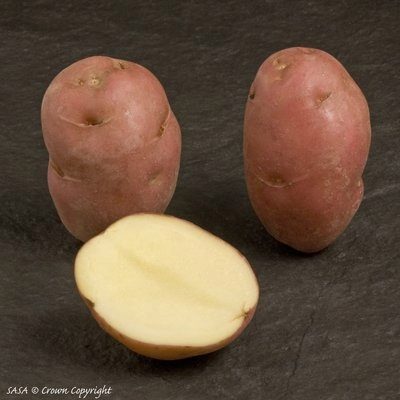
- Authors: HZPC HOLLAND B.V. Netherlands
- Name synonyms: Desiree
- Year of approval: 1997
- Appointment: table, suitable for making French fries, chips
- Tuber weight, g: 52-104
- Peel color: red
- Color of the pulp: light yellow
- Starch content,%: 13,5-21,5%
- Tuber shape: oval
- Peel structure: smooth
Desiree is a potato variety that was bred by breeders from the Netherlands. The variety has been approved for use since 1997, which means that all its properties have already been well studied, and based on the observations of experienced gardeners, beginners will be able to draw correct conclusions in matters of agricultural technology of this variety.
Description of the variety
This is a variety with high yields, which also has excellent marketability. Due to its unpretentious care, it can be cultivated in various regions, but most often it is found in the Middle Volga. Tubers can be used for almost any culinary application.
Characteristics of the appearance of the bush and root crops
The bush of the presented variety is spreading, has dark green and slightly rough leaves with medium venation, as well as red-purple flowers. Tubers are elliptical, red, weight 52-104 g, light yellow pulp. One of the advantages of the variety is its high marketability, which is 80-94%.
Purpose and taste of tubers
This variety tastes good, but it does not boil well, so it is best not to use it for mashed potatoes or as a filling for pies. But this variety will make excellent chips, French fries, country-style potatoes.
Maturation
Desiree belongs to varieties with a mid-season ripening period, the harvest is carried out 100-110 days after the appearance of the first shoots.
Yield
Desiree is very productive, on average it gives 101-139 c / ha, and the maximum - 383 c / ha.
Growing and care
The optimal time for planting is early May, during this period, return frosts are almost impossible. Before planting, tubers should be pre-treated to increase immunity against diseases. A distance of about 35 cm should remain between future plants, 60 cm between rows. Plant the planting material to a depth of 8-10 cm. Further care is as follows.
- Watering. This variety is very responsive to moisture, so water the beds once a week, however, it is important not to overdo it, overflows in the second decade of the growing season are especially undesirable. Excess moisture can provoke rotting of the fruit, which will slow down the favorable development of the root system.
- Hilling. Desiree loves loose soil, so systematically huddle. If the soil is left stone, then the fruits during harvesting may be deformed.
- Mulching. This procedure allows you to get rid of weeds that absorb nutrients without leaving them to the potatoes. Accordingly, the quality and quantity of the crop is significantly reduced.

Planting potatoes is one of the main spring activities traditional for Russian gardeners. There are many ways to plant this vegetable, allowing you to get a good harvest in different conditions and climates. Before planting, you need to carefully prepare the planting material, correctly determine the timing, competently prepare the soil.


Soil requirements
The culture of the presented variety will feel more comfortable in beds with light loam or sandy loam. It is advisable to plant the plant after winter, annual and perennial grasses, legumes. When landing in sandy loam, lupine will become an excellent predecessor.

Disease and pest resistance
The specified variety is resistant to potato cancer and viruses, but it is very vulnerable to late blight of leaves and scab. To prevent the appearance of these ailments, follow preventive measures.
- Carefully select the planting material, do not forget about pre-sowing treatment.
- Change the beds for sowing. When the ground is resting, plant an oil radish on it.
- Treat the field with herbicides before planting.
- If signs of late blight appear in neighboring areas, spray the potatoes with products containing copper.
Among insects, this culture is most often affected by Colorado beetles. Gardeners prefer to remove individuals mechanically and destroy. When a large colony appears, insecticides are used, which will also help against bear and wireworm.

Potatoes are a popular vegetable crop that many gardeners planted on their site. But growing a bountiful harvest of tasty and large tubers is unlikely to succeed if the beds are not properly protected from the most common diseases and pests. Often, the development of diseases of various etiologies of potatoes goes unnoticed, so it is important to identify the problem in time and eliminate it.
















































































